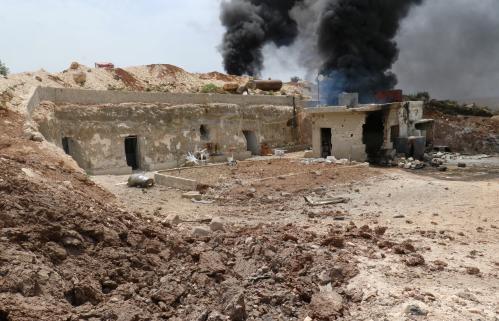There are many reasons to believe that the emergence of the Islamic State in Syria and the massive flow of foreigners to fight was due to unusual (though not unique) circumstances, argues Daniel Byman. This piece originally appeared on Lawfare.
For counterterrorism officials, one of the most difficult counterterrorism challenges is identifying the next global struggle that, like the Syrian civil war, will energize the world’s Muslims and lead tens of thousands of foreigners to join the fray. However, as a Danish proverb (not Yogi Berra) warns, “It’s tough to make predictions, especially about the future.” But while counterterrorism officials must be on alert for the next cause that, like in Syria, produces a surge of foreign fighters and terrorism, they should not assume past is prologue. Indeed, there are many reasons to believe that the emergence of the Islamic State in Syria and the massive flow of foreigners to fight was due to unusual (though not unique) circumstances.
The Islamic State evolved from what was once known as al-Qaida in Iraq, which emerged to fight the United States and the Shiite-led government of Iraq after the fall of Saddam Hussein in 2003. When the Syrian regime faced unrest in 2011, followed by all-out civil war, the al-Qaida fighters in Iraq saw an opening—and a sanctuary to exploit and expand their operations. The group benefited from the increasing repression of Iraq’s regime, which marginalized and even killed and imprisoned Sunnis, even those who were willing to cooperate with the government. From Syria, the Islamic State drew on global sympathy for the Syrian rebels and hostility to the Assad regime. Neighboring states like Turkey allowed relatively free access to the battlefield. And the Islamic State itself proved remarkably successful: At its peak, the Caliphate ruled territory the size of Britain and with a population of over 10 million people. The group also took advantage of social media to spread its message, enabling it to rapidly reach worldwide audiences.
At first glance, the situation may seem even worse for the group’s adversaries today. The Islamic State has been driven underground after losing almost all of its territory, but the group has not been defeated; thousands of members are still in the fight. Even worse, the Islamic State and other groups like al-Qaida have a presence in countries like Mali, Pakistan, Somalia, and other parts of the Muslim world. Though outflows of foreign fighters from Syria have not been huge, small numbers have made their way to Libya, Afghanistan, and other fields of jihad. Maybe even more important, the extremist networks are powerful. Typically each wave of militancy draws on the last one, and given the size of the Islamic State’s streams of outside supporters—the group attracted more foreign fighters than Afghanistan, Iraq, and other modern jihads combined—one can expect the next cause to have large pre-existing networks that would help publicize the cause, connect fighters, and otherwise facilitate a movement. The narratives that drove the Islamic State, such as sectarianism, and the anti-Americanism that motivated al-Qaida remain robust.
Perhaps most troubling, in both the United States and Europe a growing hostility and violence toward Muslims and bigoted rhetoric from top officials risks alienating non-radical Muslims and creating or worsening a sense of alienation. Often, concerns over terrorism are linked to fear of immigrants, such as the “migrant caravan” approaching the United States through Mexico that supposedly had terrorists in their ranks. In addition, growing right-wing extremism is producing anti-Muslim violence and rhetoric, which further increases the risk of alienation. Alienated communities are more vulnerable to radical recruitment and are less likely to work with law enforcement to report potential troublemakers.
Yet for all these problems, there is good reason to think a global cause that motivates Muslim extremism on a Syria-like scale may be unlikely. The struggle in Syria was unusual in part because of the early legitimacy it enjoyed. Syrian President Bashar al-Assad is a brutal dictator who has murdered hundreds of thousands of his own people. President Barack Obama called for Assad to step aside, while British Prime Minister David Cameron called him a “butcher.” Fighting Assad’s regime was hardly a marginal cause embraced only by fanatics.
As a result, the United States and other countries not only indirectly encouraged anti-Assad fighters, but they also did not intervene to help the Syrian government—in contrast to Iraq, Mali, Somalia, and numerous other countries where U.S. forces act directly to protect the government, provide indirect aid to the regime regime or local militaries, or both. There are few countries in the world like Syria, where both the jihadists and the United States strongly oppose the regime (Iran being one notable example).
As Western leaders called for opposition to Assad, the Syrian cause and eventually the Islamic State began attracting volunteers, with many governments ignoring the departure of their nationals or, as was the case in Russia, encouraging them to leave. For several years, countries like Belgium, which had one of the highest per-capita rates of Islamic State volunteers, did not build up their intelligence services or otherwise respond to the threat in a timely manner. That changed, especially after the 2015 Paris terrorist attacks. The attacks, with 130 victims, were the worst Europe had suffered in over a decade, and the worsening Syria conflict and the bloody propaganda of the Islamic State generated fears that this was a harbinger of worse to come. Even laggards like Belgium made impressive strides. Intelligence cooperation in Europe, while still needing improvement, is better than ever.
Turkey’s willingness to allow fighters to transit its border was also unusual. Other jihads had access points—Pakistan as a gateway to Afghanistan, for example. But the path was often hard and expensive, requiring extensive smuggling networks. In contrast, volunteers for the Islamic State simply showed up in Turkey, where the group escorted them across the border. Once Turkey began to police its border more aggressively, however, this flow dried up.
Technology companies also stepped up their efforts. Although they have a long way to go, they are vigorously taking down content linked to jihadist terrorist groups, streamlining coordination, hiring more staff, and otherwise improving their game. It is possible that the next group might use different emerging technologies and again catch Silicon Valley flat-footed, but thanks in part to its exploitation by extremist groups and foreign intelligence organizations, the blithe confidence in the internet’s inherent goodness is now gone for good, and it is likely that both governments and technology companies will be more vigilant.
One would hope that the mix of more aggressive policing, aid to anti-jihadist regimes, border control, internet vigilance, and other measures would make it harder for any group to succeed on the scale of the Islamic State. Using that level of success as a barometer matters. If no group is allowed to govern territory and otherwise rise to the twisted heights the Islamic State gained, then their inspirational power will also be lessened.
All this, of course, requires disciplined attentiveness. Security services must be resourced, the United States must work with allies to prevent small problems from becoming big ones, and the technology sector must assume some degree of responsibility. If these steps are taken, the chance of a repeat of Syria are far lower.









Commentary
Was Syria different? Anticipating the next Islamic State
November 20, 2018